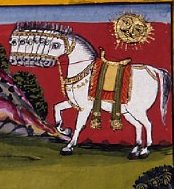User:SHIVI NAITHANI/sandbox
Wood carved Vahanas in the collection of National Museum[edit]

- Garuda(Half human-half eagle)
- Parvani(Peacock)

- Uchchaihshravas(Horse)
Method and Material[edit]
There is perhaps no feature of indian Art that manifests so great a Diversity nor so many points of interest as that of wood-work.A grammar of decorative art might in fact, be wriiten from the study of wood carving alone, and the circumstance the wood and the stone carvers be alone belong to one and same caste, may be accepted as an additional evidence in favour of gradual production of the on form the other and that at not very ancient date. Wood has been ornamented in various ways such as by carving, inlaying, veneering, lacquering, etc. The art conceptions seen in woodwork have been greatly influenced by the grain of the timber employed, such as the deep undercutting and sculptor that is possible with teak, red wood, walnut and low relief of sheesham and Deodar the incised design of ebony. The intricate and the minute detail of the sandal and the barbaric boldness of rohira, sal and babul and other coarse grained and hard woods. India has a luxuriant range of wood and every locale has its own kinds each with its particular properties of grain and strength
Mythology[edit]
Iconography[edit]
In iconography, the vahana is both the symbol and the emblem of the deity that it carries.In Hindu iconography, positive aspects of the vehicle are often emblematic of the deity that it carries. Nandi the bull, vehicle of Shiva, represents strength and virility. Parvani the peacock, vehicle of Skanda, represents splendor and majesty. The hamsa, vehicle of Saraswati, represents wisdom, grace and beauty. However, the vehicle animal also symbolizes the evil forces over which the deity dominates. Mounted on Parvani, Skanda reins in the peacock's vanity. Seated on Mushika, Ganesh crushes useless thoughts, which multiply like rats in the dark. Shani, protector of property, has a vulture, raven or crow in which he represses thieving tendencies. Under Shani's influence, the vahana can make even malevolent events bring hope.

